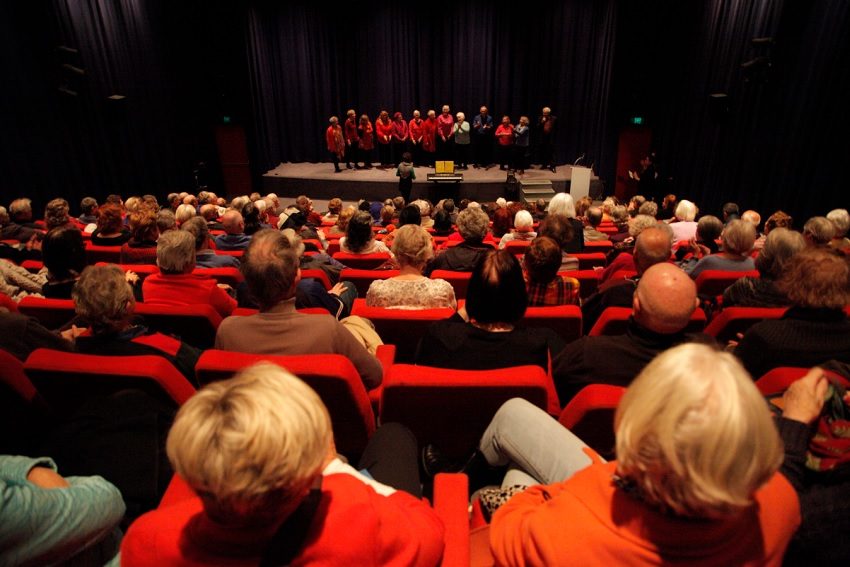Building Communities Through Film

Our viewing habits may have changed but what hasn’t is our sense of community, as cinemas are now places where people can interact as well as enjoy film.
While more people might be going to the cinema than ever before – with 69 per cent of us heading to the cinema every year according to stats from Screen Australia – the real change is in the number of times we visit. This number has declined in almost every demographic and is most notable with teenagers. Teenagers visited a cinema 16 times a year in the ‘70s and now they visit as little as seven times a year. This means we are watching fewer films together and, when we do, it is a narrower range of films.
You witness this change living with teenagers. Unless it’s connected to a major cultural phenomenon – aka a franchise film where not seeing it might constitute social death – cinema attendance is a last resort activity. Driving past our local mum and dad-run cinema, my daughter once said to a new friend, “We used to go there a lot but hardly ever now” – i.e. ‘we are way too cool for all that’.
Meanwhile laptops and phones are carried everywhere as numerous YouTube stars impart wisdom from how to put on your make-up to why eating eight bananas a day will help change the hierarchical relationships between the species. Rather inspiringly, as teenagers stack the dishwasher, what may also run in the background are documentaries on what’s really happening in Syria.
Netflix is an ever presence in our household, less so iView. My teenagers discovered Please Like Me from the former and despite being raised on a diet of ABC children’s TV, they never switch to it. Does this mean the ground is being laid for a future that is less in touch with Australian content?

(Photo: Andre Castellucci)
A take-out some years back from watching the Joy Division documentary was just how similar the good modernist education all of us got in the West during the 1960s and ‘70s. From Adelaide to Manchester and beyond, we read the same novels, studied the same plays and could quote the same poets.
What particularly worries me about the decline in cinema attendance – accompanied by the rise of myriad streaming platforms – is the loss of a shared watching culture. Though many obsess over Game of Thrones, a lot of us don’t tune in, stream or download it. With the screen our most dominant cultural platform, we are exploring, testing and resolving our values less as a group.
Cinema attendance is strong amongst the aged and new migrant communities at The Mercury, where we have been revived partly on the back of Seniors on Screen. Growth continues despite competition from interstate packages chasing the senior dollar and major cinemas dropping prices. Seniors on Screen remains popular because it was first built as a community and secondly as a way of selling tickets. It was originally tagged as an over-50s club for the digital age.
The guiding light is tackling social isolation amongst the aged. Alongside a great and diverse range of films from across the globe, the focus is on learning patrons’ names, sharing cups of tea and coffee, having speakers and other activities such as the occasional group lunch, trading tables as fund raisers and an irregular choir. In just a decade we have created an attached culture.
Attached cultures to bricks and mortar cinemas are also being built amongst the many emerging migrant communities that hire cinemas to build and maintain relationships and language. Similarly to Seniors on Screen, there is a strong gathering in the foyer around refreshments and making real connections. It is something more than the ubiquitous launch and a Q&A with a glass of bubbles. Cinemas can be platforms seguing migrant communities into the broader society, as they find their bearings. Interestingly, members of these communities are looking for local pathways into the film industry, and, why not, as both Iran and India have great national cinemas.
Bricks and mortar cinemas have a role in keeping people connected and involved. Except for libraries, western society now has no other active cultural infrastructure that is as widely spread as cinemas. The cinemas that build communities may have the strongest chance of survival.
In South Australia, we have a new generation of talented young filmmakers poised for success. In February, Sean Lahiff’s short Smashed premiered at the Berlin International Film Festival, later this year Victoria Cocks will shoot her first feature – the vampire flick, In The Blood – and Anthony Maras will release his Weinstein Company film, Hotel Mumbai. Therefore, while the young may attend cinemas less, young content makers are still aiming for the big screen.
All these young filmmakers have been involved in the MRC, which aims to play the long game in terms of investing in people first. Investing in young artists builds Australian content and investing time in individuals builds a community, which, in turn, becomes your audience.
Gail Kovatseff, Director, Media Resource Centre and Mercury Cinema
mrc.org.au
mercurycinema.org.au